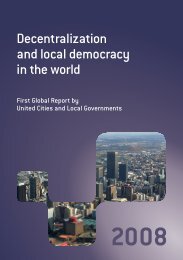Making Cities Resilient Report 2012
Making Cities Resilient Report 2012
Making Cities Resilient Report 2012
You also want an ePaper? Increase the reach of your titles
YUMPU automatically turns print PDFs into web optimized ePapers that Google loves.
well as the Mayor of Quito) are working on awareness programmes and training in disaster risk reduction,<br />
alongside other safety issues of violence and road safety. Quito’s ‘my school is prepared’ programme<br />
includes training, contingency planning, and emergency drills (35). Other cities have integrated disaster<br />
risk reduction into education on broader pro-environmental practices. For example, school programmes in<br />
Colombo teach solid waste handling to reduce flood risk (17), and Chacao has an ‘EcoEscuelas’ programme<br />
that addresses environment and risk issues (55). Schools in some cities, such as Cairns and Saijo City, are<br />
integrating risk reduction into the school curriculum to ensure that all children are reached 14 .<br />
Overcoming lack of awareness of disaster risk reduction amongst<br />
professionals and decision-makers<br />
Mumbai, Bhubaneswar, Thimphu and cities in Pakistan identified the lack of knowledge about disaster risk<br />
reduction at all levels as a key challenge to building resilience. To address this, these cities (and others)<br />
offer training to core service professionals and local government workers. Bhubaneswar’s Municipal<br />
Corporation has trained engineers, architects and planners in earthquake vulnerability and response in<br />
order to improve implementation of hazard-resistant building codes and increase the quality of hazardproofing<br />
activities in new and existing structures. The city has also trained volunteers from NGOs working in<br />
disaster risk reduction on hazard mapping. A similar approach has been adopted in Batticaloa, where risk<br />
design and management are now part of the standard curriculum for planners, architects, and engineers.<br />
Box 4.8 : Palestinian university moves risk reduction agenda forward<br />
The An-Najah National University in Palestine held the first Palestinian Urban Forum, which brought<br />
together municipal representatives and local institutions to discuss issues related to safe cities and<br />
disaster risk reduction and review the basic elements necessary to make cities resilient to disasters.<br />
The forum concluded by recognising the need to establish a Palestinian strategy for disaster risk reduction<br />
that encourages municipalities and local governments to join the ‘<strong>Making</strong> <strong>Cities</strong> <strong>Resilient</strong> Campaign’ and<br />
implement the Ten Essentials throughout their work.<br />
The forum also emphasised the need to activate the High Council of Civil Defence; adopt a special fund<br />
for disasters at the national level; and provide training programmes on disaster reduction at all levels and<br />
sites (schools, universities and institutions).<br />
UNISDR and partners have undertaken training sessions for councillors and local government officials in<br />
many cities – and local governments identify the Campaign’s positive role in improving their awareness<br />
of disaster risk reduction principles at early stages of resilience building. UNISDR has also engaged<br />
parliamentarians on this issue, encouraging them to convene discussions on decentralising risk<br />
management capacity and legislative frameworks (see the example of Lebanon below; Bangladesh,<br />
Uganda, Benin are other examples). This in turn has fed into greater political will to develop and enforce<br />
policies to reduce urban disaster risk. Ancona highlighted how their participation in the Campaign has<br />
increased awareness of disaster risk reduction amongst politicians, as well as providing access to<br />
technical information.<br />
14. In Saijo City, the value of regular school-based disaster risk reduction education in seen at the household level, when children home the<br />
information learned at school. Since 2006, risk awareness courses have been held three times a year as part of the ‘12-year-olds disaster<br />
prevention education’ project. Educational field trips about risk – either ‘mountain-watching’ or ‘town-watching’ –help engage the children and<br />
help them to make associations between the classroom and ‘real life.’ (39, 48)<br />
56 | <strong>Making</strong> <strong>Cities</strong> <strong>Resilient</strong> <strong>Report</strong> <strong>2012</strong>

















